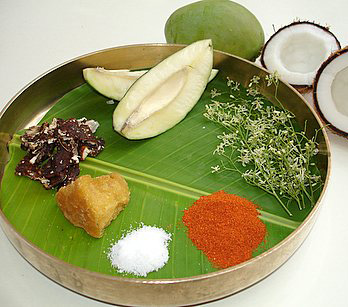What is the significance of the Yugadi celebration? What is the story related to Yugadi celebrations? Is it similar to other festivals? What are its roles as a prominent festival? Festivals are a kind of rejuvenation break for mechanical life. They bring vibrant colors and optimism to everyone. In India are generally festivals are related to Lords’ birthdays, mythological reasons, seasonal changes, etc. Yugadi is one such festival that is celebrated diversely in different regions of India.
Yugadi – meaning and celebration:
The term Yugadi is derived from two Sanskrit words: Yuga (year) + Aadi (beginning). It literally means “THE BEGINNING OF THE NEW YEAR”. We celebrate Yugadi on Chaitra Shuddha Padyami. It means Chaitra – the first month of the Hindu Calendar, Shuddha – the bright fortnight, and Padyami – the first day. Alongside, according to the Gregorian calendar, the festival falls in late March or early April. The Deccan people in India celebrate it as New Year.
Yugadi and change in nature:
Yugadi is a festival that welcomes the spring season. The entire nature appears to be in the festive spirit during the season of Yugadi. With the new leaves, new buds, fresh breeze, and bright sunlight nature symbolize the colors of spring. Hence, it is also a token of gratitude to nature for providing humans with the very best necessities things.
As aforesaid, Yugadi is one festival that has a diverse range of celebrations in different regions of India. It also has different names in various states of India. Kannada and Telugu people denominate it as Yugadi or Ugadi. Whereas people of Maharashtra and some regions of Goa label it as Gudi Padwa and Cheti Chand by the Sindhis.
Celebration of Yugadi:
Yugadi is celebrated with great pomp in Karnataka, Andhra Pradesh, and Telangana. They decorate the entrances of houses with the garlands of Mango leaves and neem leaves. The day starts with a fresh shower by applying oil all over the body. Followed by prayers and Panchanga Shravanam which means reciting the almanac (Hindu calendar). Many people sit around a priest or an astrologer to listen about the future happenings of the entire year. The almanac readings predict the average annual rainfall, harvests, etc. based on the celestial calculations. Further, the family members in the houses of Karnataka consume a mixture of Neem flowers and Jaggery. Whereas, people in Andhra and Telangana prepare a special dish called Ugadi Pachadi. It consists of six flavors sweet (jaggery), sour (tamarind), salty (salt), bitter (neem flowers), spicy (chilly), and tangy (mango).

The six flavors signify that life is a mixture of all six emotions and one has to balance everything. Sweet indicates the happy moments while bitter is a symbol of difficulties. Similarly, the other flavors like spicy, salty, sour, and tangy refer to anger, interests, challenges, and sudden surprises in life respectively.
Scientific significance of Yugadi rituals:
The fragrance of mango and Neem leaves heals the airborne diseases. It also prevents harmful bacteria from entering the houses. Applying oil specifically castor oil removes excess heat from the body, also gives good nourishment to the skin. The Yugadi mixture also has some health benefits like – the Neem flowers prevent skin allergies, jaggery obliterates the chances of anemia. Salt keeps the body hydrated, spice improves the immune system, tamarind improves digestion, and mango improves blood circulation.
Mythological stories behind the celebration of Yugadi:
As said in the first paragraph, there are traditional or mythological reasons behind every Hindu festival. By the same token, the lord associated with Yugadi is the creator, Lord Brahma.

Lord Brahma is the creator of lives and the four Vedas. Once, a demon called Somakasura robbed the Vedas from Brahma and hid them underwater. So, Brahma went to Lord Vishnu seeking his help to find the Vedas as it is essential in creating lives. Forthwith, Lord Vishnu took Matsyavatara (One of the forms of Lord Vishnu – the form of a fish) and went underwater to fetch the lost Vedas. Subsequently, he found the Vedas and returned them to Lord Brahma and in due course, Brahma became gleeful and started creating the Universe (lives/kali yuga). It is believed that the creation process started on Chaitra Shuddha Padyami which is the day of Yugadi, and hence the festival is celebrated for the same reason. Alongside, this is the only festival in association with Lord Brahma.


In Addition, there is another story with respect to Yugadi. According to records and astrological calculations, it is the day when Lord Krishna departed from the earth. Thus Dwaparayuga ended and Kaliyuga began.
